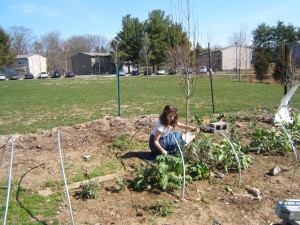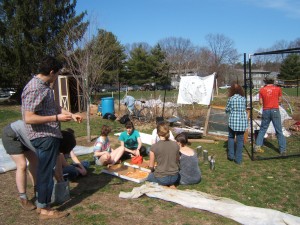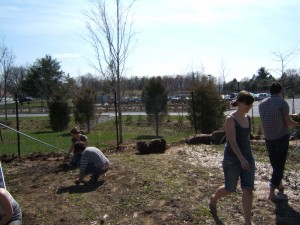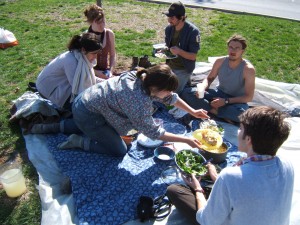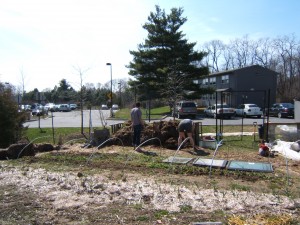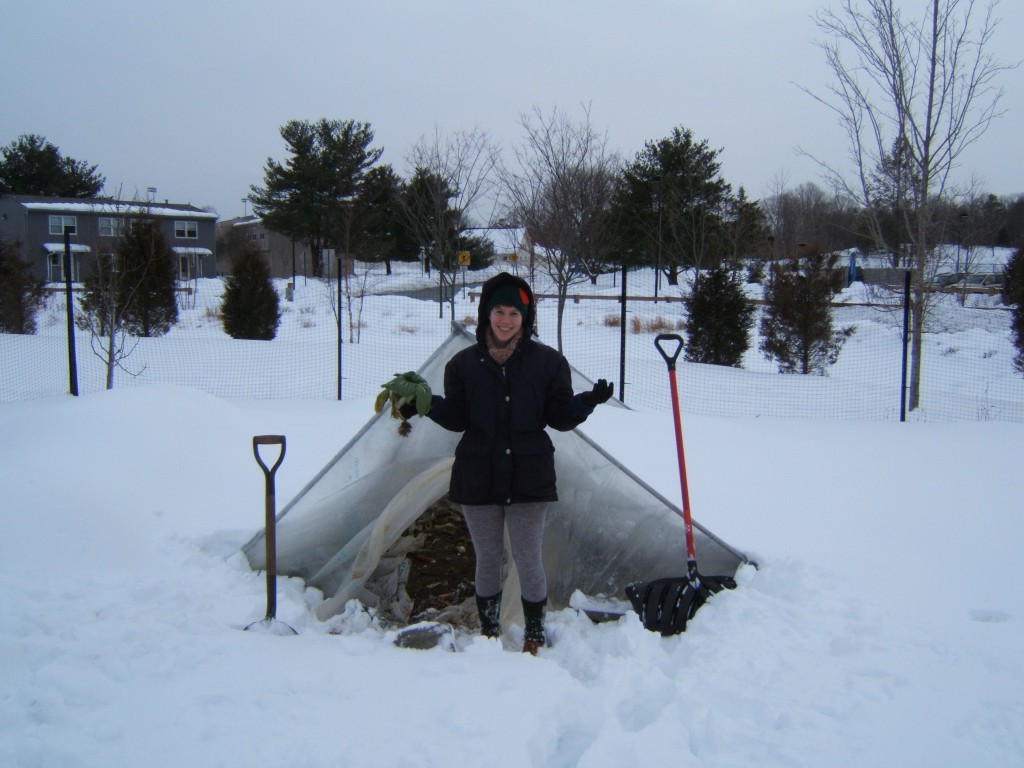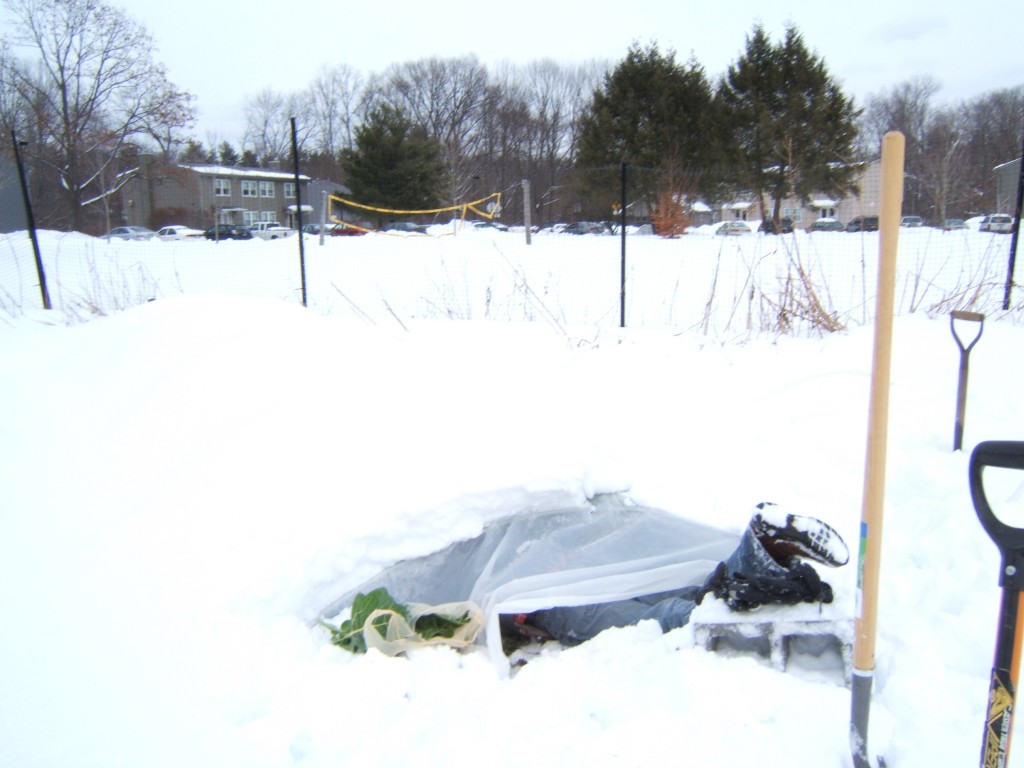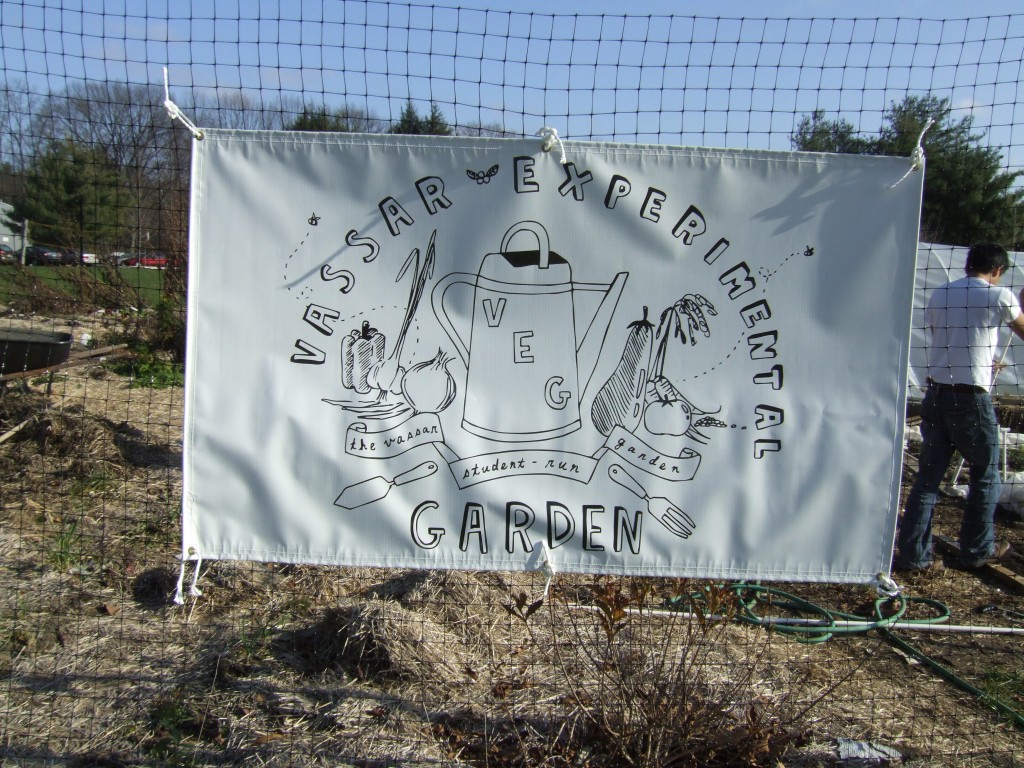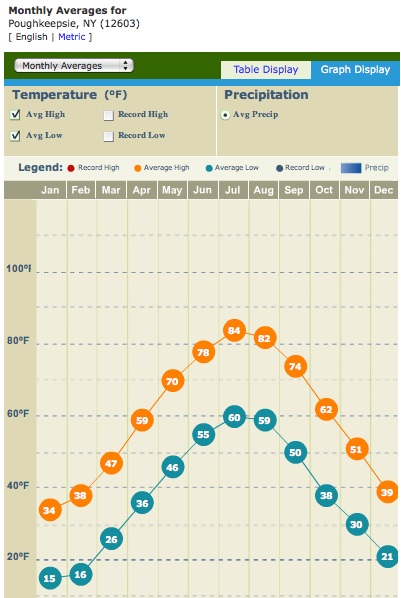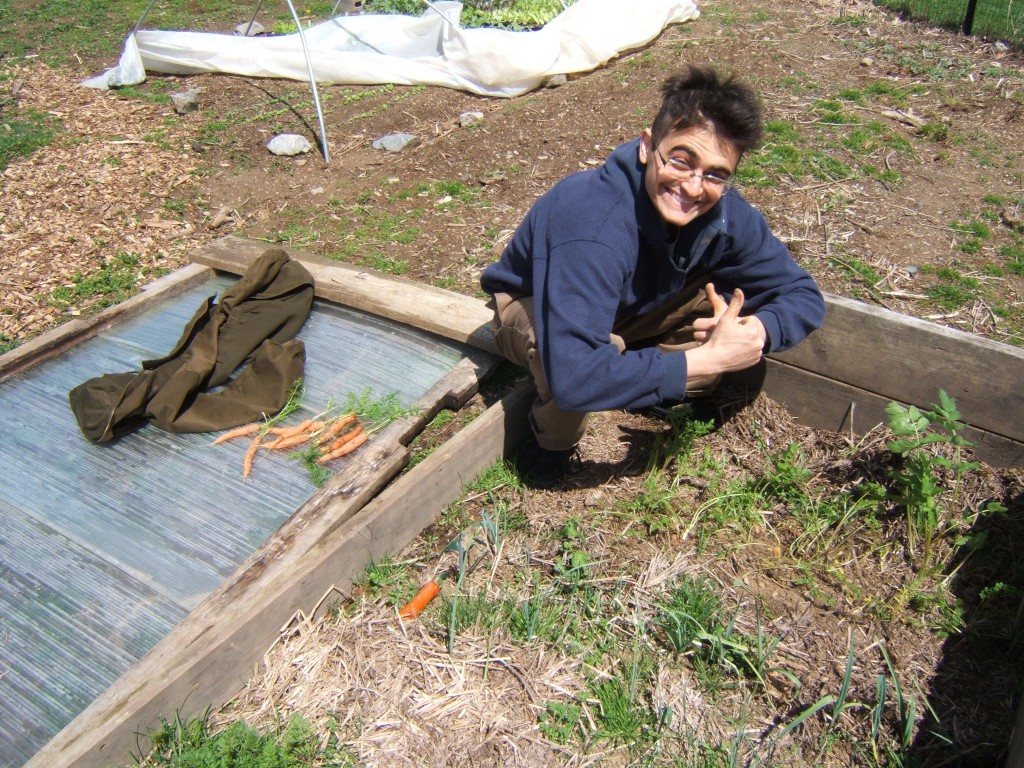spring round-up ready
June 1, 2011
hoop (house) dreams
June 1, 2011
Depending on how the summer crew has fared, we usually start with a clean-up day- weeding the garden, throwing out broken equipment and other detritus, turning the compost, etc.
Because we have a limited time frame in the fall to get things in the ground in time to reap the benefits, it’s best to seed as soon as possible upon returning to school. We usually try to have some sort of planting scheme in place in time for the first clean-up. The design of the scheme has to incorporate the fact that later on in the semester, certain beds will be covered up with hoop houses, so the dimensions of the beds should be determined accordingly. If we remember correctly, the width of the bent hoops is about 5 ft, so beds that will go under hoops should be 5 ft wide.
Here’s a video from Johnny’s seeds about hoop houses- this is where we got the idea to use aluminum piping (EMT, whatever that means).
http://www.youtube.com/watch?v=pREajJWSV2Q&feature=player_embeddedThe hoop bending tool is in the shed and there is still some unbent piping between the shed and the garden fence.
We used these last year and it worked well, the hoops held up under feet and feet of snow:
In choosing where the hoops will go and what crops should be grown in those beds, use this chart as a guide.
Master(b8r) Plan
June 1, 2011
| Date range | What to start, what to cover, what to transplant, etc. |
| First two weeks of fall semester (Beginning of September) | Direct seed
Fall greens: arugula, mizuna, other mustard greens, mâche, claytonia, tatsoi, lettuce, spinach Roots: radish and turnip |
| Transplant
(seedlings started during summer) Brassicas: kale, collards, nappa cabbage, bok choy, chard (not actually a brassica but just go with it) |
|
| Cover
All transplanted beds should be covered with light weight row cover to help protect against pests (link to pest entry) and speed their growth |
|
| Harvest
Whatever is ripe/ready: tomatoes, peppers, eggplant, broccoli, cabbage, radish, turnip, summer squash, cucumber, melon, escarole/frisée, sweet corn, tomatillos, okra Selectively/over time: greens, beets, carrots, chard, collards, kale, leeks, onions, herbs |
|
| Remainder of September | Harvest
Entire crop at once: potatoes, dry beans (+ same as above) |
| Prepare for storage
Potatoes (see post) Dry beans (see post) Dry corn (see post) |
|
| Early October | Plant and mulch (with hay)
garlic |
| Harvest
Entire crop at once: remaining basil (make pesto and freeze) and dill Whatever is ripe/ready: tomatoes, peppers, eggplant, broccoli, cabbage, radish, turnip, summer squash, cucumber, melon, endive/frisée, sweet corn, tomatillos, okra Selectively/over time: greens, beets, carrots, chard, kale, leeks |
|
| Late October | Cover
If nighttime frosts (< 32°) are predicted then crops should be covered with heavy weight row cover (This row cover is effective for temperatures down to 26°. Ideally the cover can be applied in the evening and opened up in the late morning) |
| Harvest
Entire crop at once: winter squash (when vine dies) Whatever is ripe/ready: tomatoes, peppers, eggplant, broccoli, cabbage, radish, escarole/frisée, turnip, tomatillos, okra Selectively/over time: greens, beets, carrots, chard, collards, kale, leeks, napa, bok choi |
|
| Prepare for storage
Winter squash |
|
| Early-Mid November | Cover
If nighttime frosts (< 32°) are predicted then crops should be covered with heavy weight row cover |
| Pull and Compost
Finished summer crops: tomatoes, peppers, eggplant, tomatillos, okra |
|
| Harvest
Selectively/over time: greens, beets, carrots, chard, collards, kale, leeks, onions, brussels sprouts, Jerusalem artichoke |
|
| Late November (pre-Thanksgiving break) | Cover
Cover crops with plastic. (Remember carrots and beets can be overwintered, cover with mulch and cover with season extender- cold frame, low tunnel, etc. No need to cover brussels, cabbage, broccoli, Jerusalem artichokes) |
| Harvest
(same as above) |
|
| Spring prep
Prepare beds that aren’t planted with winter crops for planting by turning in compost and cover with layer of mulch. In early Spring the mulch can be pulled off and the beds will be ready to go. |
|
| Early December | Harvest
(same as above) |
| Late January (post-Winter break) | Harvest
(same as above) |
| Maintenance
Keep season extending structures clear of snow build-up |
|
| Early-Mid February | Start seeds in greenhouse
Brassicas: cabbage, broccoli, kale, chard, collards, bok choi, napa cabbage Asters: lettuce, escarole/frisée |
| Harvest
(same as above) |
|
| Mid-February-Early March (before Spring break) | Start seeds in greenhouse
Solanaceous: peppers, eggplant, tomato Alium: onion, leek, scallion Apium: celeriac |
| Harvest
(same as above) |
|
| Late-March – Early April | Direct seed
Rhubarb crowns, horseradish roots (both in herb circle), peas Greens: arugula, mizuna, mixed mustard, spinach (sow these under cover to speed up growth. Start taking cover off during the day once seedlings are established), lettuce (don’t sow lettuce under cover because it does not germinate if it is too hot) Brassica: radish, turnip (also cover) Lilliaceae: asparagus crowns |
| Harvest
(same as above) |
|
| Mid-April | Start seeds in greenhouse
Cucurbits Summer squash, zucchini, cucumber, melon (these can be started in mid-March) Herbs: cilantro, dill. Parsley Brassicas: broccoli, cabbage Solanaceous: tomatoes (for late summer/fall) |
| Transplant
Brassica seedlings started in February (Transplant into pre-prepped and mulched. Cover these beds with plastic or heavy row cover a week before transplanting to warm the soil. Leave cover on) |
|
| Late – April | Direct Seed
Chives |
| Harvest
Young greens and overwintered crops |
|
| Weed
everything |
|
| Pull and compost
dead overwintered crops |
|
| Early May | Weed
everything |
| Pull and compost
dead overwintered crops |
|
| Mid-Late May | Direct Seed
Potatoes and corn |
| Transplant
Cucurbits: summer squash, zucchini, cucumber, melon Solanaceous: pepper, eggplant, tomato Alium: onion, leek, scallion |
|
| June | Direct Seed
Cucurbits: melon (for late summer/early fall) and Winter squash Apium: Parsnip |
| Transplant
tomatoes |
|
| Start in Greenhouse
Brassicas: brussels sprouts, cabbage, broccoli |
|
| July | Transplant
Brassicas |
| Direct Seed
Beets, carrots |
|
| Harvest
Alium: scallions, garlic scape |
|
| August | Harvest
Garlic (if leaves are starting to die) |
Potatoes, winter squash, and dry beans are a useful crop for a student garden because they can be planted right before students leave for summer vacation and will be ready when the fall semester begins. They can also be
Dry beans need to be winnowed (removed from shells)- you can do this several ways: each pod individually by hand, or by putting the pods in a tarp and jumping on it/beating it, etc. and then separating out the pods. If you can get a big fan to blow across the tarp, the pods- which are lighter than the beans- will blow away. Beans can go in a jar, paper bag, etc.
Potatoes and winter squash are best stored in a root cellar, though we have been successful storing them in our kitchen for 2-4 months. We have fantasized about making our own root cellar using a barrel. Check out this tutorial- dreams do come true:
Frosty Date
June 1, 2011
Frost dates are the estimated day that the first frost of the fall and the last frost of the spring can be expected. These are important dates to keep track of as frost can make or break a lot of crops. The frost date helps determine when cover should go on certain crops, when others should be harvested, and when to remove cover. That said, it’s important to pay attention to the weather day to day, as an exceptionally hot fall or early spring day can cause plants to bolt (go to seed) if left under their covers.
The estimated first (fall) frost date for Poughkeepsie is early to mid-october, sometime between the 7th and 15th. The last (spring) frost date is in late April.
The frost dates are particularly pertinent to the following plants that can be successfully maintained with season extenders but are sensitive to too much heat:
- Arugula
- Mustard greens
- Spinach
- Mâche
- Claytonia
The following vegetable can be successfully maintained during the winter with season extenders but are particularly sensitive to frost and cold weather:
- Lettuce
- Nappa cabbage
- Chard
- Escarole/frisée
- Fennel
We also find this chart of monthly average temperatures useful:
Cold Frame (of Mind)
June 1, 2011
Cold frames are an excellent season extension technique that can compliment using low hoop tunnels. We have explored a number of cold frame designs over the years, including using hay bale frames, wooden frames, and glass and plastic.
Cold frames can come in all kinds of shapes and sizes and VEG is always interested in creating new and improved designs. One of the things that experience has taught us over the years is that heavy winter snow can cause glass panels to shatter. Plastic panels seem to work well because they will merely bend under the extreme weight. If glass is used in a cold frame it should be occasionally cleared off so that snow doesn’t accumulate extensively. Or you can put the glass or plastic panels at a steep enough angle so that snow will merely slide off, preventing it from accumulating to begin with. Hinges can be attached to one side of the frame for easy lifting and removing of the panels.
The wooden cold frames VEG used have been the most convenient and sturdy. We salvaged and recycled wood from various sources.
Cold frames have numerous uses: overwintering crops, hardening off transplants in the spring, and extending the season in both the early spring and fall.
